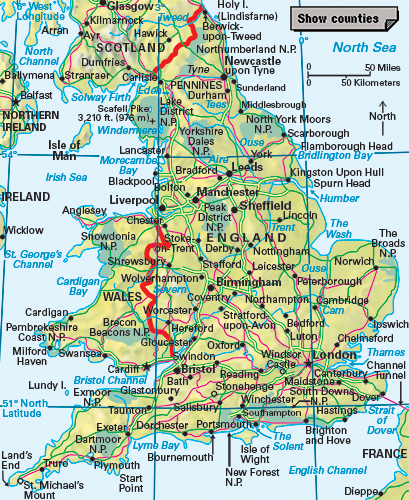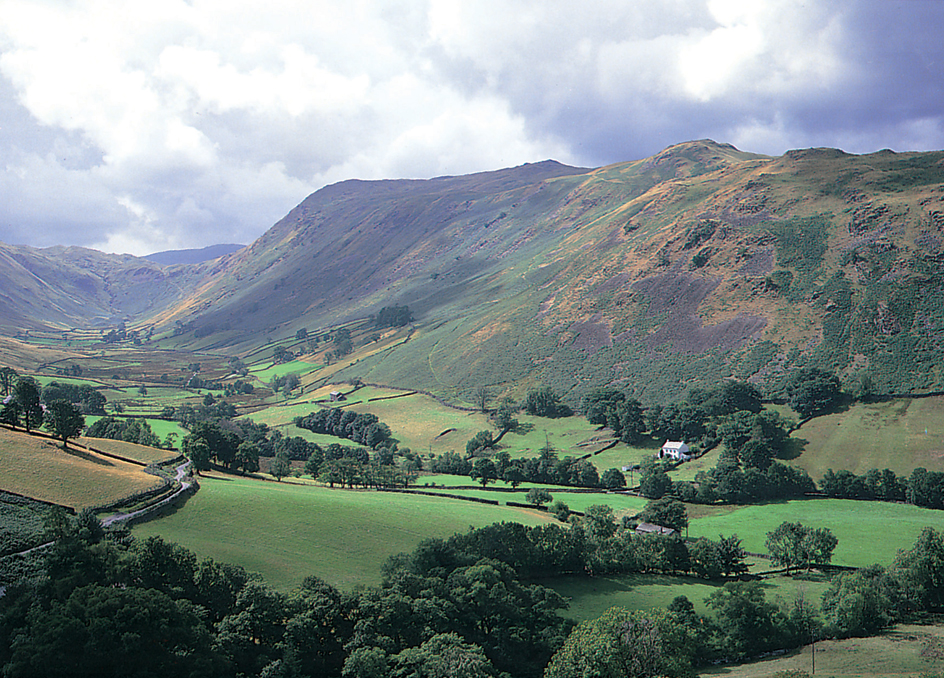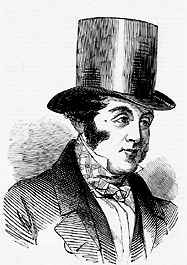Yorkshire (pop. 4,887,115) is a large geographical area in northeastern England. It covers the county of North Yorkshire, the East Riding of Yorkshire, the nine metropolitan areas that make up the southern and southwestern parts of Yorkshire, and the ancient cathedral city of York. North Yorkshire is almost entirely rural. The southern and southwestern parts of Yorkshire are mainly industrial and urban. These parts are made up of the two metropolitan counties of South Yorkshire and West Yorkshire.
Yorkshire is famous for its important industries, its beautiful scenery, and its fine buildings. Its industries include the iron and steel mills in the Sheffield area and the clothing and textile factories around Bradford and Leeds. Nearly all of the United Kingdom’s supply of woolen goods is produced in Yorkshire. The Yorkshire Dales have some of Yorkshire’s most beautiful scenery. They lie in the western part of Yorkshire. Fine buildings in Yorkshire include York Minster and Castle Howard. Fountains Abbey, near Ripon, was founded in the early 1100’s.

Economy.
People have been making woolen textiles in Yorkshire for hundreds of years. The industry started in the work of yeoman-clothiers, who combined small-scale farming with spinning yarn and weaving cloth. Gradually, the two industries became separate and then became organized in large factories. In recent years, Yorkshire workers have used increasing amounts of synthetic fibers in addition to wool.
Bradford is the main center for processing raw wool, and for dyeing, spinning, and weaving. At its famous wool exchange, merchants buy or sell imported wool. Leeds has a clothing industry, with several large factories producing shirts and dresses. The city also has hundreds of small tailoring workshops and an extensive footwear-producing industry.
Halifax workers specialize in making carpets, and Huddersfield workers produce high-quality worsted cloth. In the towns of the heavy woolen district between Halifax and Wakefield, workers make cheaper clothes and blankets.
Engineering is nearly as important an industry as textile manufacturing in Bradford, Halifax, Huddersfield, and Leeds. The area around Rotherham and Sheffield has an old established iron and steel industry. Several large companies produce girders, rails, and large steel plates. Sheffield is also famed for the manufacture of cutlery and razor blades.

Coal mining has historically been important to Yorkshire’s economy. In the 1920’s, large coal reserves were discovered beneath the Vale of York, between Selby and York. Many of Yorkshire’s coal mines have closed, but coal still contributes to the economy.
The main areas of farming are in the lowlands of the Vale of York and in the Vale of Pickering. Wheat and barley are the main crops. But sugar beets, potatoes, and vegetables are important in the southern part of the Vale of York.
In most lowland areas, farmers grow crops and raise animals, particularly cattle and hogs. In the higher areas, especially the Pennine moors, sheep graze on the rougher higher pastures. In the valleys, cattle raising is more important. Wensleydale, the valley of the River Ure, is famous for its cheese.
The Yorkshire coast has several seaside resorts, of which the best known is Scarborough. Many tourists visit the Yorkshire Dales and North York Moors national parks, or historical towns such as York and Richmond.
Land.
Yorkshire is bounded by the North Sea along its eastern edge. The region extends about 87 miles (140 kilometers) from north to south and nearly 100 miles (160 kilometers) from east to west. Its total area makes up almost one-eleventh of England.
The western half of Yorkshire includes a range of hills known as the Pennines, which rise to heights of more than 2,000 feet (600 meters). A series of geological faults run across the Pennines from east to west. The faults, called the Craven Faults, divide the Pennines into two regions. To the north of the faults are limestone hills, full of underground streams and caves. To the south of the faults is sandstone known as millstone grit. Parts of this area are badly drained and covered by peat moss.

The Vale of York runs north to south in the middle of Yorkshire. At its widest, the vale is about 28 miles (45 kilometers) wide. It narrows in the north to 15 miles (24 kilometers) in an area called the Vale of Mowbray.
The eastern half of North Yorkshire has two hilly regions, the Cleveland Hills and the North York Moors. These regions are windswept moors, rising to a maximum height of about 1,500 feet (460 meters). To the south of these two ranges of hills is the Vale of Pickering, a flat plain 30 miles (48 kilometers) long and approximately half as broad. A great deal of the vale is poorly drained and liable to flooding.
Yorkshire’s coastline is rugged. It has rocky headlands such as Filey Brigg and sandy bays such as those at Scarborough and Whitby.
Most of the rivers in Yorkshire rise in the Pennines and flow to the east. The upper valleys of the rivers form the Yorkshire Dales, of which the best known include Airedale, Swaledale, Wensleydale, and Wharfedale. The River Ouse flows through the Vale of York, and on into the Humber estuary.
History.
Stone Age people moved into the Yorkshire area in about 8000 B.C. Archaeologists have found flint tools and weapons in Victoria Cave, near Settle, and at many other places in the North York Moors and the Pennines. People of the Bronze Age also left many indications of their life in the area, especially in the Yorkshire Wolds and in Airedale.
When the Romans arrived in the area, it was inhabited by the Brigantes, Iron Age people who were Celtic in origin. The Romans established their local headquarters at Eboracum (York). They established other forts at Cataractonium (Catterick), Danum (Doncaster), Derventio (Malton), and Olicana (Ilkley). They built roads connecting these and other forts and leading to their lead mines in the Pennines. Roman roads included the Great North Road, which linked London with the north of England. The Roman Emperor Constantine the Great was in York when his father died. Constantine was proclaimed emperor there in A.D. 306.
After the Romans left, the Angles invaded the area. Edwin, a king of the Angles, became a convert to Christianity in 625. Following this conversion, missionaries began to preach the Gospel to Edwin’s subjects. In 664, a dispute between Celtic and Roman missionaries was settled, in favor of the Romans, at the Synod of Whitby.
The Vikings raided Yorkshire frequently during the 700’s and 800’s. Danes, led by Ivar the Boneless, captured York in 867. The city was called Jorvik for a century and was the capital of a Danish kingdom.
After the Normans invaded England in 1066, they spent several years fighting in Yorkshire before they controlled the area. When the survey for the Domesday Book was made in 1086, many places were recorded as having been laid waste. The Normans built many castles. The remains of some of these castles can be seen at Conisbrough, Richmond, Scarborough, and York.
During the Wars of the Roses in the 1400’s, supporters of the houses of Lancaster and York fought in Yorkshire. Lancastrian supporters were strong in the west and south. Yorkists controlled most of the northern part of Yorkshire.
Yorkshire has a long tradition of prominence in British religious affairs. John Wycliffe, regarded by many as the founder of English Protestantism, was born in Yorkshire in the early 1300’s.
Many abbeys were built in Yorkshire during medieval times. They were closed by King Henry VIII during the 1500’s, and most of them were destroyed. Beautiful ruins remain at Fountains, near Ripon, and at Rievaulx, near Helmsley.
During the English Civil War, several important battles were fought in Yorkshire. In 1644, Oliver Cromwell defeated Prince Rupert in the Battle of Marston Moor.
Yorkshire was greatly affected by the Industrial Revolution. The coal fields of southern and western Yorkshire developed greatly, providing fuel for the textile and iron and steel industries. Towns such as Bradford, Leeds, and Sheffield grew rapidly. These three towns were 10 times as big in 1860 as they had been in 1760. Canals and railroads developed to provide transport for industrial materials. George Hudson, the Railway King, made his native city of York into a railway center.

Yorkshire artists and writers include J. B. Priestley, who was born in Bradford. Haworth, near Bradford, is famous as the home of the Brontë sisters, Anne, Charlotte, and Emily.
